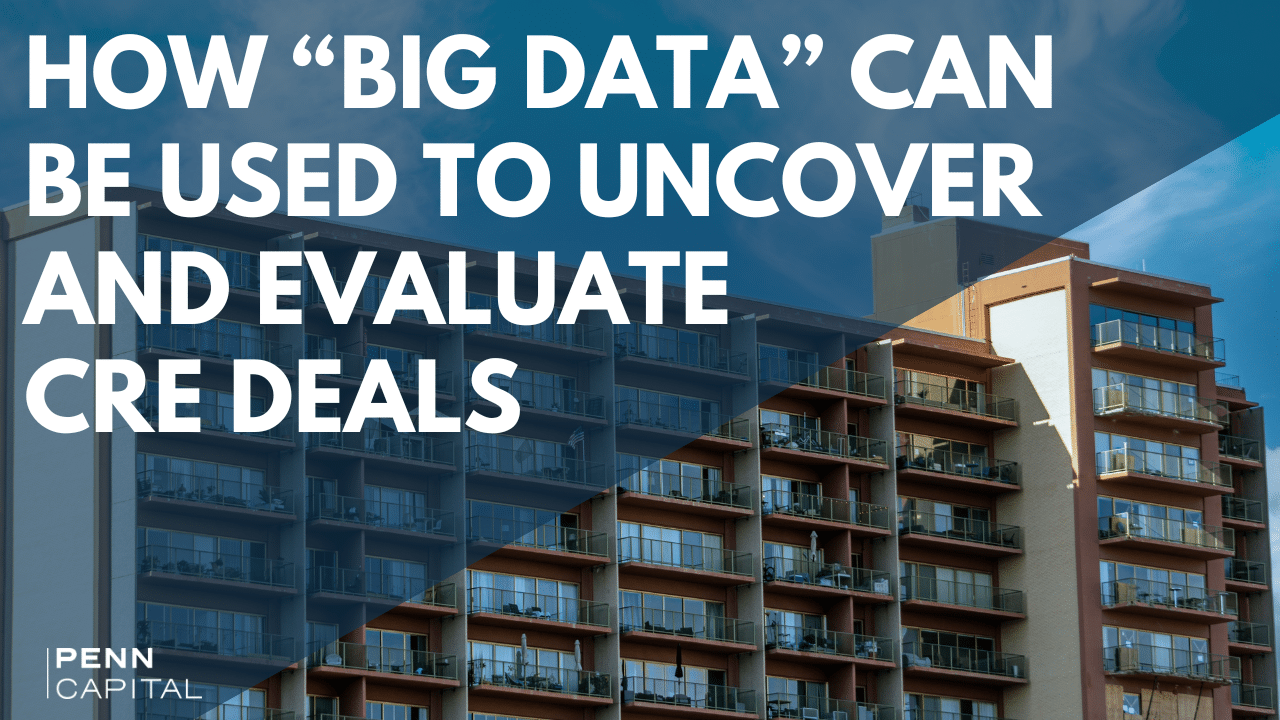How “Big Data” Can be Used to Uncover and Evaluate CRE Deals
By Ed Rogan, Owner, Co-Founder

As commercial real estate becomes a more mainstream asset class, there are more people competing for the same, limited number of deals. Increasingly, real estate investors are scouring the landscape for off-market deals. This is where “big data” comes into play. Savvy private equity real estate developers will use a combination of public and private data to source the best deals for their investors’ consideration.
Not sure where to get started? Here’s a brief overview of different types of public and private data available to real estate investors, with a specific look at how investors might use each type of data.
Public Data
Historically, real estate investors had to comb through public records in order to find ownership and property data. Public data sources include mortgages and deeds that have been recorded, usually with the county Registry of Deeds. The deed will tell you who sold the property to whom and for what amount. This is a good starting point for anyone looking to learn more about who owns a property, including for how long they’ve owned it.
Mortgages are also recorded with the Registry of Deeds. Most commercial real estate transactions involve some sort of debt. A record of that debt is then made publicly available. This is a good way to learn how highly levered an owner is on any given property. For example, when scouting potential real estate deals, a private equity fund manager might note that an owner has held a 32-unit multifamily property for 20 years. Their original mortgage was only in the amount of $800,000 and, at least per public records, it does not seem as though that owner has refinanced or placed new debt on the property since. This is good intel to have. If the fund manager knows that the property is now worth well north of $5 million, it is safe to assume that the owner has significant equity in the deal. It may be worth approaching this owner to gauge their willingness sell, or alternatively, enter into a joint-venture in which they’d contribute the land/building value as equity and the fund manager would aggregate the remaining capital needed to redevelop the property into a higher or better use.
Monitoring publicly-available transaction data is critically important for real estate fund managers looking to stay ahead of the curve. Anyone who has been in business for long enough will have established a reputation in their target market(s). As such, it is likely that people will bring them off-market deals from time to time. A fund manager who has their pulse on transaction data will quickly be able to evaluate the merits of a deal.
Private Data
There are several companies – software platforms, brokerage companies, and more – who aggregate robust public and private data sets for use by commercial real estate industry professionals. For example, CoStar provides users with granular, verified data that would be difficult for an individual to compile on their own. Property-level data includes vacancy, rents, sales comps, tenants and more.
Meanwhile, a platform like Reonomy can provide robust ownership information. For example, most commercial real estate is actually owned by a third-party holding company, such as a limited liability company (LLC). If you were to search the publicly available Registry of Deeds, the deed and mortgage may only reference the name of the LLC. It takes another level of research to uncover who is actually behind that LLC, information that is usually made available through a state’s Secretary of State’s office.
Once you find the LLC that has been registered with the state, you can then find the name of an agent who has filed documents with the state on the LLC’s behalf. This could be an attorney, it could be one of the Managing Members of the LLC. It really varies. Even if you know the signatory filing paperwork on the LLC’s behalf, you still have to find that person’s contact information to make an introduction.
Public records may include a mailing address but certainly will not include a phone number or email address. Private data sources will aggregate this information on users’ behalf, making it easier than ever to find ownership information, including robust contact information. Obviously, having that contact information is critical when trying to connect with an owner about a potential real estate deal.
ProspectNow is another source of privately-aggregated data. ProspectNow uses predictive analytics to help identify properties that are likely to be listed for sale within the next year. This data gives investors a jumpstart—they can approach an owner prior to that owner listing the property for sale on MLS. ProspectNow also provides information about expired MLS listings. This information can lead investors to properties that, for one reason or another, did not generate enough interest to result in a sale. Using tools like these is a great way for fund managers to find off-market commercial real estate deals.
Sign up to receive our educational newsletter and to gain exclusive access to our next investment opportunity.
Leveraging Big Data to Find and Evaluate Real Estate Deals
Finding real estate data is just the first step. Now, a private equity real estate manager needs to make sense of that data. Knowing how to leverage big data – how to really analyze and extrapolate that real estate data – is what sets apart the good from the great real estate fund managers.
Let’s say a real estate investment company is focused on only a single product type in a single geography, such as multifamily in Greater Philadelphia. Using a combination of public and private data, a fund manager can easily search for multifamily properties with 50+ units located within a 10-mile radius of Centre City. To narrow their search even more, they can then search for apartment buildings constructed prior to 1980. Older properties may be in greater need of renovation, and therefore, may present an opportunity for a fund interested in value-add multifamily deals.
When vetting potential deals, the manager can then use other forms of “big data” to do some preliminary underwriting. What is a realistic property value? That will depend, at least in part, on in-place and market rents. This first level of due diligence can be done prior to contacting an owner or touring a property. By leveraging big data to weed out most deals early on, the fund manager can then focus their attention on the diamonds in the rough show the most promise.
RELATED ARTICLES
5 Keys to Investing in Distressed Real Estate
5 Keys to Investing in Distressed Real Estate By Ed Rogan, Owner, Co-Founder Buying distressed real estate certainly isn’t for the faint of heart. An inexperienced investor can easily be swayed by the promise of a project sponsor who doesn’t actually have a plan for turning the property around. But that doesn’t mean you shouldn’t…
READ MORE >Gaining an Edge through Cold Calling
Gaining an Edge through Cold Calling By Ed Rogan, Owner, Co-Founder In many ways, commercial real estate is an “eat what you can kill” industry. The most successful investors, developers, brokers and other CRE professionals earn their living by scouring the market to uncover the next big deal. Ask the industry’s best and they’ll often…
READ MORE >Trial by Fire: How We Got Started
Trial by Fire: How We Got Started By Ed Rogan, Owner, Co-Founder People often use the term “trial by fire” to explain how they learned something. In our case, the term is all too appropriate. Looking back on it, the story of how Percy and I got started almost seems unbelievable. We were just…
READ MORE >


